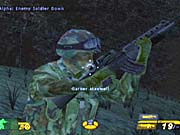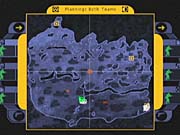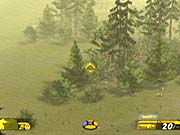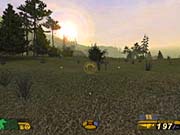Originally released for the PC last year, Tom Clancy's Ghost Recon was a squad-based first-person shooter that followed in the basic footsteps that were set by its predecessors, the memorable Rainbow Six and Rogue Spear games from Red Storm Entertainment. Though it differed considerably in its plot and setting, Ghost Recon was still a methodical, slow-paced action game that required a good deal of planning in order for your team of highly trained military operatives to succeed in their objectives. Ultimately, it was another good game in Red Storm's venerable line of tactical shooters, but it suffered from a bad case of poor AI and had a less-than-stellar interface to boot. Nearly a year later, Ubi Soft has released the Xbox port of Ghost Recon, and even though there might not appear to be a lot of changes outwardly, the game does in fact have numerous changes. To be sure, some of the problems from the original Ghost Recon still persist, but this Xbox port is wholly satisfying, and its Xbox Live support transforms what was largely a straightforward multiplayer component on the PC to a fun and addictive experience.

Like the recently released Splinter Cell, Ghost Recon takes place in the near future and focuses on tensions in the Caucasus region of the former Soviet Union. Specifically, the game is set in 2008, and right-wing nationalists have seized control in Moscow and launched a war campaign to envelop all of the former Soviet states that gained independence in the early 1990s when the Iron Curtain fell. As part of an elite US Army unit called the Ghosts, you're sent into the region to wreak havoc with the new Soviet regime's plans. The single-player campaign spans the length of 15 individual missions, by the end of which you'll be leading your team of trained and skilled warriors into the very heart of Russia itself--the Kremlin--to overthrow these radicals once and for all.
Before jumping into any one of these missions, you're given a text and voice briefing that includes the latest background information on the war, as well as your mission parameters. Outlining these proceedings is a map in the right-hand corner of the screen that denotes all your primary and secondary objectives, your insertion point, and your extraction point. On the game's easiest setting, neutralizing all the enemies in any given level will automatically satisfy all your primary and secondary objectives, and the mission will end successfully without your having to return to the extraction point. This isn't the case under the veteran or elite settings, however, where you'll have to actively complete all of your objectives before being able to move on to the next mission. Additionally, whereas the completion of the primary objectives is required, the secondary objectives simply net you additional bonuses in the form of unlockable characters and unique weapons.
After these briefings, you're taken to a loadout screen, where you'll be able to custom-tailor your entire squad to your liking. In Ghost Recon, you'll carry out your missions with six soldiers split into two teams of three. The game also has four distinct soldier classes: rifleman, which is your standard elite infantryman; support, the group's heavy gunner; sniper, a long-range recon unit; and demolitions, which carries most of the team's explosives. Furthermore, each one of these classes can be equipped four different ways depending on your preference. For example, you can opt to have your support gunner carry his primary M249 SAW and several frag grenades for close engagement or extra ammo instead. What's more, after you complete a mission, you'll be given a certain number of points that you can allocate into one of four skills for your soldiers. These skills--weapons, strength, leadership, and stealth--have a concrete effect within the game, but you're not always better off choosing soldiers with more experience, since once a soldier dies, you lose all his points forever.
You can choose to equip your soldiers any way you want, and you can assign any available soldiers to the six slots on your two teams, though how you customize your team should be strongly influenced by the mission briefings. If you're told to expect tanks or other armor, you'd be wise to bring along two demolitions experts and equip them both with M136 LAWs. Obviously, Ghost Recon is a gun nut's dream, as it features more than 20 real-world weapons that have been made famous in recent years by games like Counter-Strike and Operation Flashpoint on the PC. Everything from the standard-issue M16A2 infantry rifle to the deadly Barrett 50-caliber sniper rifle will eventually be available to you in Ghost Recon, and each serves a unique purpose that translates well within the actual missions.
The missions themselves are very well laid out, and they often include scenarios unique to this genre, as well as ones that have been borrowed from popular culture. One mission, for example, tasks you with investigating the crash site of a downed Sea Hawk in the middle of Tbilisi. As you wind your way through the war-wracked city streets, taking fire from behind cars and building doors, finally turning the corner to reveal the helicopter wreck, you can't help but relive some of the moments from Black Hawk Down. In fact, most of Ghost Recon's missions are very atmospheric, and though the game might not wow you with its visual splendor, its astounding ambient sound effects go a long way toward making you believe that you're actually part of the action. The very first mission, for example, tasks you with raiding an insurgent camp located on the face of a mountain in Georgia. As you make your way higher up the mountain, you'll note that the wind gradually changes from a light breeze to a strong gust. And if you happen to approach a certain cliff near the peak, you'll be greeted with an absolute howl that'll practically have you buttoning up your jacket.

The game's inherent slow pace and sense of realism also add to its believability. This isn't Unreal Championship, where you can jump around like a rabbit while absorbing loads of damage. In fact, you can't even jump at all in Ghost Recon. Your movement and the entire execution of any given mission are very methodical in this game. In every mission, your team will be greatly outnumbered, and it takes only two or three shots to kill one of your squad members. Thankfully, the game lets you assume control of all six of your squad members, though never at once. By hitting the Y button, you can cycle through your entire squad, and the five soldiers who aren't under your control at any given time will know to defend themselves properly. Ghost Recon for the PC suffered from some serious AI issues, and some of these still linger in the Xbox version of the game, though to a somewhat lesser extent. Most of these problems seem to involve doors. Specifically, it's easy to inadvertently leave your squadmates "trapped" in a house or building after you leave, since they often attempt to pass through two at a time and get stuck in the process. Other times, they'll block you in a doorway or a narrow hallway, leaving you frustrated in your attempts to pass. Unlike Rainbow Six or Rogue Spear, Ghost Recon was clearly developed with the wide outdoors in mind, and some problems arise in the few places in the game that force you to go indoors.
During combat, however, your two teams will shine. Because of the game's green and brown color palette, spotting camouflaged enemy soldiers can be tough, and oftentimes the noise you make will draw enemy fire to you before you're able to see where the attack is coming from. Your squadmates will more often than not spot enemy soldiers before you do, and depending on how you've set their rules of engagement, they'll either open fire or report their position to you. Additionally, the game makes use of a threat indicator that shows you the general direction and distance of enemy locations, as well as the direction of gunshots in general. In addition to adding stealth skills to all of your soldiers, you can crouch or go into a prone position to reduce your visibility to others, and the rest of your team will follow suit. By tapping left or right on the D pad, you can even lean around objects to get a better feel for your surroundings without exposing yourself. You can also use a command menu to set the rules of engagement and lay waypoints for your two teams to follow. This interface is drastically improved over the PC version, which made giving orders a somewhat clunky ordeal. The new interface is much bigger now, and it lets you zoom in by pressing down on the right analog stick for finer placement of your troops. By moving the right analog stick around, you can quickly change the demeanor and rules of engagement for both of your teams, easily eyeball the status of all six members of your squad, and assume the role of any team member. Combat in Ghost Recon will border on paranoia, since you'll spend much more time scanning your surroundings and sending your other team on short patrol routes than you will shooting.

As you progress through Ghost Recon's 15 single-player missions, you'll unlock new quick game modes that will let you play any one of the campaign missions in any order. And even though there's no dynamic placement of enemies in the game, some of the soldiers that you'll encounter will never be standing still. Many will be on patrol, meaning that they won't be in the same place where you might have encountered them before. This adds a little bit of replay value to the game's single-player maps, but it's in the multiplayer component of Ghost Recon that this game shows its true worth. Ghost Recon supports up to four players via split-screen and four times that number via the Xbox system link. The really fun part, however, is Ghost Recon's Xbox Live mode. Using either the optimatch or quick match options, you'll have no trouble finding a server with a healthy number of people playing. And whereas the voice communication might be somewhat gimmicky in other Xbox Live games, its integral to a game like Ghost Recon. Using the command menu, one player will often tell the rest of the team where to go and where the closest enemies are. During particularly heated firefights, many of the players will yell things like "I'm hit!" and "Where's it coming from?" Obviously, these events are completely unscripted, and they only serve to suck you deeper into the game. Playing over Xbox Live isn't perfect, however. Depending on the host's connection, the voice communication will often distort or drop out altogether for brief moments at a time. Also, to talk, you need to hold down the white button on the Xbox controller, which is awkward at first, especially considering that most other Xbox Live-compatible games don't require you to do so. Additionally, the game doesn't support split-screen when playing an Xbox Live game, even though it does via a system link match. What's more, there's no way for the host (or anyone, for that matter) to boot people from the lobby. This can be a problem if up to 15 other players are waiting for a single person to hit the ready button. The only solution in cases like this is to drop out of the game and create or join a new match.
To be fair, though, these points are nitpicky. The multiplayer experience of Ghost Recon on the Xbox is much more satisfying than in the PC version, and the game includes other fixes or enhancements--like a revised interface, a new auto-aim feature, and the ability to rename saved games--that make this game a better experience on the console than it was on the PC. Another major reason for this is Ghost Recon's phenomenal sound effects. The game now supports Dolby Digital 5.1 audio, and if you have the right speaker setup at home, you'll be able to hear ambient sound effects all around you, and more importantly, you'll instantly be able to tell the general direction of gunfire, which is very loud and very convincing in the game. When one of your squadmates says "right behind you," his voice will literally come from right behind you. The game's music is great as well. Like in the PC version, it's composed largely of drums and brass instruments that produce a somewhat patriotic score, though also like in the PC game, this music plays only during the menus.

Unfortunately, the graphics, which could have used a good shot in the arm, received no such boost in the transition to the Xbox. To be clear, Ghost Recon doesn't look bad at all. In fact, the 3D models of your squadmates look very good, especially the ghilly suit-clad snipers, who even have their sniper rifles covered in the shrublike fabric. Moreover, the soldiers move with fluid animation, many of the tanks and armored personnel carriers that you'll encounter look very imposing, and trees and shrubs sway subtly in the wind. However, the levels and the rest of the characters in the game are modeled with a low number of polygons, the sky often resembles nothing more than a flat bitmap, and all of the textures in the game are low resolution and extremely blurry.
You wouldn't expect a game like Ghost Recon to make the transition to a console very well. After all, its slow pacing and realism give it a distinct PC flavor. And yet you'll have no trouble controlling the action, thanks to the few but key changes that were made in the Xbox version. Additionally, Ghost Recon makes excellent use of the Xbox Live service, giving it replay value well beyond that of its PC counterpart. In a crowded genre of similar action games, you'll undoubtedly find Ghost Recon to be a welcome addition to the Xbox library. It would have been nice if the game had updated graphics and better squad AI, but as it is, this is a great game nonetheless.